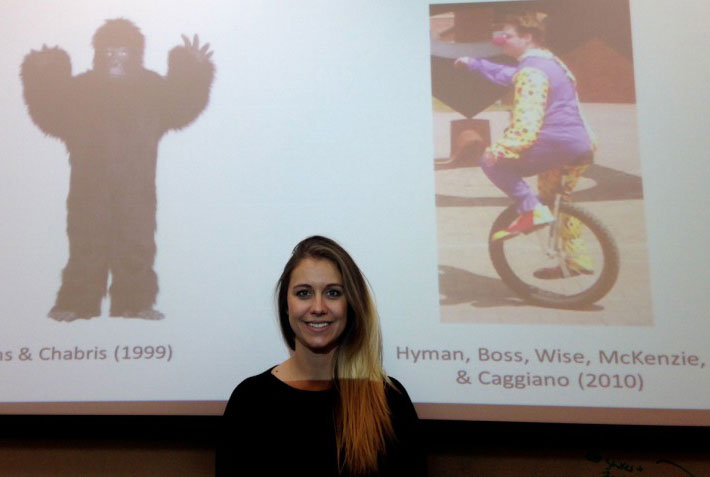The Gorilla in the Room: Inattentional Blindness Isn’t Blindness At All


Imagine being so engrossed in a task that you don’t notice a gorilla entering the room. (This actually happened in a famous psychological experiment.) The phenomenon is known as “inattentional blindness” and occurs when people are so focused on a task that they fail to notice unexpected events. But it turns out that inattentional blindness isn’t blindness at all.
“We know that inattentional blindness exists, but we wanted to know whether it’s really ‘blindness’ – where we don’t take in the information at all – or if we are just not fully processing the information we take in,” says Allaire Welk, a psychology Ph.D. student at NC State who led a study on the subject.
It’s an important subject because inattentional blindness applies to more than just gorillas. For example, driving is a complicated mental task, but drivers need to be prepared to switch their attention to unexpected events at any time – such as changing traffic patterns, road closures or pedestrians crossing the street.
 “There are a lot of practical applications for inattentional blindness research,” Welk says. “For example, if we can understand this phenomenon, then we may be able to manipulate road signs to make them more noticeable to drivers.”
“There are a lot of practical applications for inattentional blindness research,” Welk says. “For example, if we can understand this phenomenon, then we may be able to manipulate road signs to make them more noticeable to drivers.”
To explore this issue, Welk and two other NC State researchers devised a visual game in which there were 10 black circles and 10 white circles. A red dot was placed in one of the 20 circles and a green dot was place in another. Study participants were asked to count how many times one of the colored dots was transferred to different circles in the display over a 20-second time period.
After each trial, participants were asked how many times the relevant colored dot moved, and how confident they were of their answer. Participants were also asked whether anything unexpected had happened during the trial, and how confident they were of that answer. There were 21 participants in the study, and each participant “played” 72 trials.
In half of the trials, an unexpected event occurred. If the player was tracking the green dot, this unexpected event would be for the red dot to turn green, black or white. If they were tracking the red dot, the green dot would turn red, black or white.
“If people were tracking the green dot, we found that they were more likely to notice the red dot becoming green than they were to notice it becoming black or white,” Welk says. “We believe this is because the color green was associated with what they were doing – tracking the green dot. It was task relevant.”
Overall, in sessions that included unexpected events, participants noticed “task relevant” events 80 percent of the time, but only noticed 67 percent of “non-task relevant” events.
“The term ‘blindness’ is a misnomer,” Welk says. “Inattentional blindness is not blindness at all – we’re taking in the information. We propose changing the name to ‘attentional acuity,’ since the phenomenon is really linked to how our brains selectively filter information.
“We’re now experimenting with different scenarios to learn more about how we mentally process unexpected events,” Welk says.
By Matt Shipman, NC State News Services.
A paper describing the work, “I Was Blind But Now I See: A Manipulation of Task Relevance on Inattentional Blindness,” is published in Proceedings of the Human Factors and Ergonomics Society 58th Annual Meeting. Welk is the lead author. Co-authors are James Creager, a Ph.D. student at NC State, and Dr. Douglas Gillan, professor and chair of NC State’s Department of Psychology.
- Categories:


